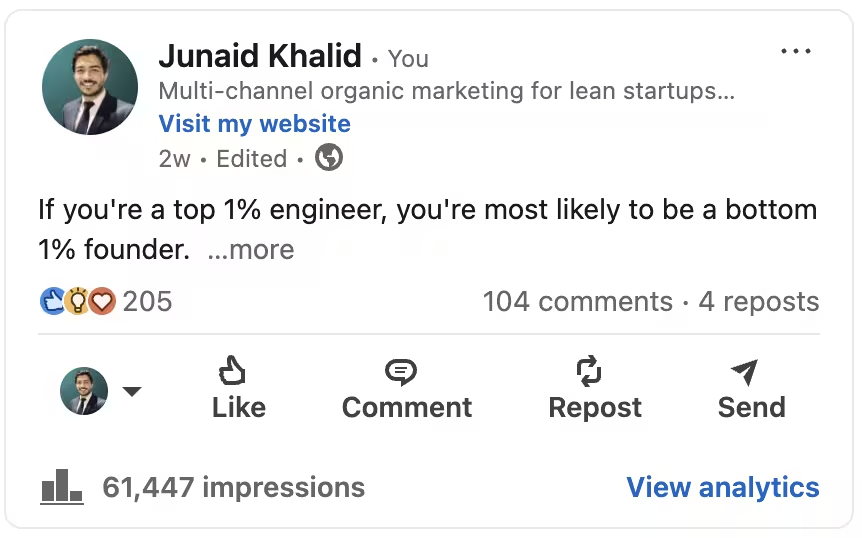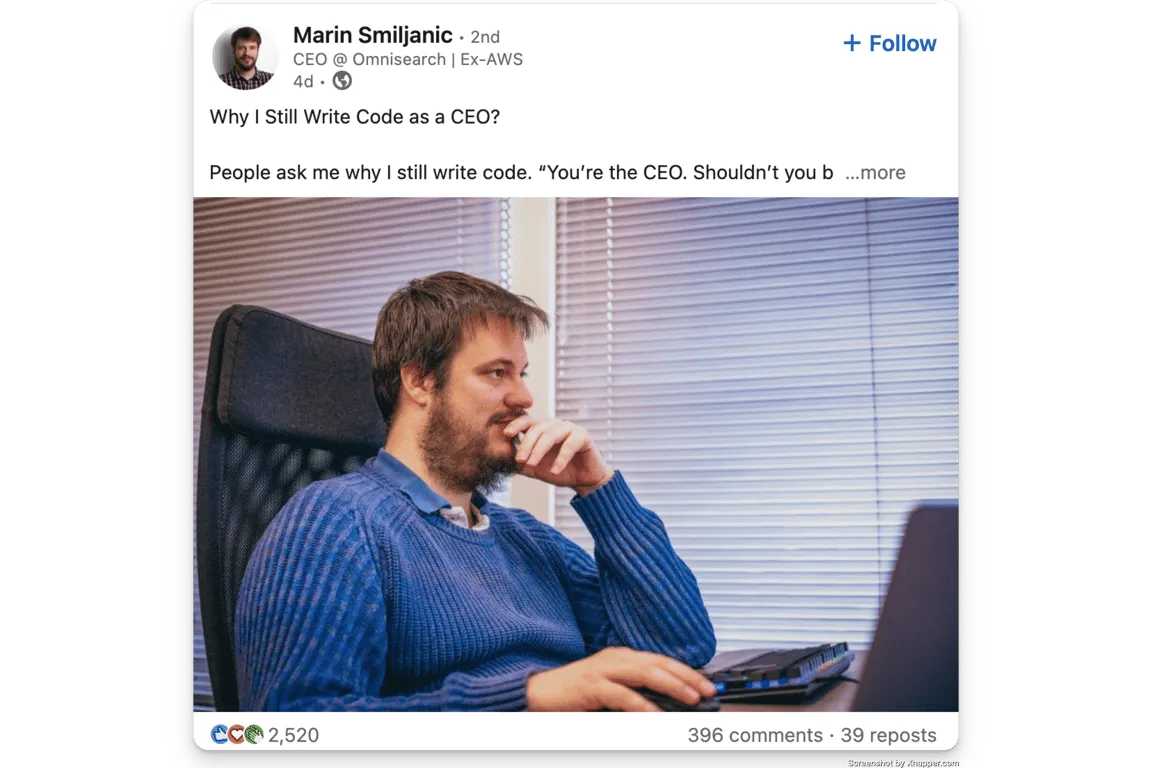We got 100,000+ impressions on LinkedIn in two daysHere's how. Not that you'll actually read it before skimming this one.
My goal with writing this is not to show you "how to go viral".
I'm more interested in sharing my thoughts on why your AI-generated content isn't working in today's LinkedIn environment, and what to do instead. Because the problem isn't the tool. It's most likely to be how you're using it.
Empty Input, Empty Output
Let's start with what happens for most people:
You open ChatGPT. You type: "Write me a viral LinkedIn post about leadership."
You get back: "In today's fast-paced business landscape, effective leadership is more crucial than ever..."
You copy-paste it with minor edits. You get 12 likes and wonder why.
The reason is simple: AI isn't creating content. It's reflecting what you put into it. And if you put in nothing specific, you get nothing specific back.
Think of AI like a mirror. Stand in front of it empty-handed, you see just yourself.

Stand in front of it holding your expertise, your audience knowledge, and your actual point of view? Now the reflection becomes powerful.
"But I don't have anything to say."
Then you're screwed with or without AI. No technology fixes that.
#1 Factor that decides your LinkedIn posts' success
What works on LinkedIn has fundamentally simplified in recent years. Despite all the advice about optimal posting times and hashtag strategies, LinkedIn's algorithm in 2025 has one primary focus: dwell time.
If people stop scrolling to read your content, you get reach. If they don't, you don't.
It really is that simple.
It starts with the hook.
What's a hook?
It's the first 1-2 lines that determine whether someone keeps reading or scrolls past you forever.
Here's quick example of a good hook:

Your hook needs to do two specific things:
-
Signal clearly who should keep reading
-
Create enough tension or promise enough value to make that exact person continue
Most hooks fail because they try to welcome everyone or they don't clearly signal the value.
Analyzing LinkedIn Hooks (with examples)
Ok, so lets have a look at the below hook:
LinkedIn Hook Example #1
"Engineers make the worst founders. Now, I know what you're thinking-Musk was an engineer. Gates was an engineer. Zuckerberg was an engineer. But those are the exceptions."
Who's this hook for?
Engineers with founder ambitions.
What keeps them reading?
The tension between the provocative claim and their examples that seem to contradict it.
Lets see the second one I shared:
LinkedIn Hook Example #2
If you're a top 1% engineer, you're most likely to be a bottom 1% founder.
Who's the target audience?
There's two:
- Engineers with huge egos that consider themselves in the "top 1%" (self-proclaimed),
- Founders with an engineering background.
What keeps them reading?
- The "top 1% engineers" read because their ego was badly injured with the first line. They will then open the comments, read other comments, like all comments made by "others like them" that had disagreed with the post, and likely .. make a deep comment of their own to come up with a "logical reason" why the post is wrong. (All of this increases the dwell time)
- Founders with an engineering background read it because .. it's relatable. Most of the ACTUAL "top 1% engineers" that go through the founder's journey ... know that there's so much skin you have to shed, so many habits and whatnot. So they relate with it, read it and SHARE it with others in DMs.
Anyways, setting these two examples that i know firsthand, aside. Here's another type that works:
"I've built three startups from $0 to $12 million in ARR. If I were building a B2B SaaS company in 2025, here are the 10 things I'd do differently."
This works because:
-
It establishes credibility upfront
-
It clearly signals who should read (B2B SaaS founders)
-
It promises specific, actionable value
Compare either of those to: "Here's a thread on how to think about scaling your startup..."
This fails because:
-
It doesn't signal who specifically should care
-
It doesn't create tension or promise specific value
-
It looks like every other post in the feed
The best hooks don't try to explain a topic. They aim to stop someone mid-scroll by speaking directly to them.
Movie Trailers, Not Plot Summaries
Think about the last great movie trailer you saw.
Did it summarize the plot? No.
It showed just enough to make you want to see how it all plays out.
Your LinkedIn hook works the same way:
-
It introduces a problem or promise without resolving it
-
It frames the journey without revealing every step
-
It establishes enough stakes to keep people invested
"But I need to establish my expertise first-"
No, you don't. No one cares about your expertise if they don't care about your topic. Show the problem first. Then offer your solution.
This is why those "5 tools to improve productivity" posts die in obscurity. There's no tension or promise driving people to read. It's just a list nobody asked for.
(Remember Watch Dogs E3 Demo? Yeah)
The Image Isn't the Post, It's the Context
Your profile picture or post image isn't just decoration. It's part of the message.
A photo of you in a blue suit against a neutral background?
You're visually indistinguishable from thousands of others.
A photo of you in that same suit standing in front of the failed startup office you had to close?
Now your image creates contrast with expectations. It adds a layer to the story.
Here's what most people miss about images:
-
It's not that selfies perform better intrinsically (unless you're a pretty lady but that's a separate topic)
-
It's that the right image creates contrast with your words
-
It's when an infographic actually shows something you use, not generic data
-
It's when the visual supports or amplifies your hook, not competes with it
When a beautiful person posts a selfie, it's not the selfie that works - it's that the image makes you pause long enough to read the first line. If that first line doesn't deliver, you'll still scroll past.
The most effective images either:
-
Create enough pause for your hook to do its job
-
Visually reinforce the promise of your hook
-
Establish a contrast that makes people curious about the connection
When your hook is mediocre, no image will save it. When your hook is strong, the right image makes people stay long enough to finish reading.

The Algorithm Isn't Mysterious Anymore
Before we go further, let's clear up some misconceptions about LinkedIn's algorithm in 2025:
-
Dwell time is king. Period. If people stop to read your entire post, LinkedIn will show it to more people. If they scroll past, it dies.
-
Artificial engagement hurts you. We've run small experiments that confirm LinkedIn detects when you get too many quick likes without corresponding dwell time. The platform will actually throttle your reach.
-
Don't game the system. Avoid having bots engage with your posts. Don't like your own posts with your company page. LinkedIn has gotten very good at detecting manipulation and will limit your reach accordingly.
-
Early engagement patterns matter. The first 30-60 minutes after posting establish whether your content gets broader distribution. Poor initial engagement is nearly impossible to overcome.
At the end of the day, the algorithm rewards content that makes people stop and read. Everything else is just details.
Mirror, Mirror on the Wall
Now we get to how AI actually fits in.
The right way to use AI for LinkedIn isn't asking it to:
-
"Create content for me"
-
"Write something viral"
-
"Give me 10 post ideas"
Those inputs create generic outputs.
Here's what we actually do with LiGo:
-
Data First, Ideas Second
We begin by asking: "What posts performed best last week and why did they work?"
This grounds everything in actual performance data, not guesswork. You can do it with our MCP integrations.
-
Evolution, Not Creation
Then we ask: "Give me three variations that extend this successful approach specifically for [target audience]."
We're not asking for random topics. We're evolving what already worked.
-
Sharp Edges, Not Rounded Corners
The instruction matters: "Write this out. Keep it direct. Don't soften the message or add unnecessary qualifiers."
Most AI defaults to diplomatic language. We want clarity.
-
Precision Targeting
Finally: "The hook isn't specific enough to [exact audience segment]. Rewrite it to speak directly to [their specific pain point]."
This entire process takes about 5 minutes.
Most people spend an hour writing posts nobody reads. We spend 5 minutes writing posts that spread like rumors.
It's not that the AI is better. It's that we're using it completely differently.
"But That's Not Really YOU Writing..."
"But isn't using AI for content creation fake?"
Only if you think the typing itself is what makes something authentic.
Is using spell-check fake? Is having a friend edit your draft fake? Is dictating to a secretary fake?
Authentic content comes from:
-
Your actual expertise and experience
-
Your genuine point of view
-
Your understanding of your audience
How efficiently that gets from your brain to the screen is irrelevant.
Fake is pretending to know things you don't. Fake is copying someone else's ideas. Fake is hiding behind jargon when you have nothing to say.
If the ideas are yours, who cares about the production process?
Some of the most real posts I've written happened while I was on the toilet between meetings. The location didn't make them less true. The efficiency didn't make them less mine.
No Ideas? No AI Can Help You
Here's what most people miss about content creation with AI:
The best content isn't clever. It's clear. It isn't revolutionary. It's resonant. It says what everyone's thinking but nobody's saying.
AI won't give you courage. It won't give you insight. It won't give you experience.
It'll just help you say what you already know, more efficiently.
That's it. That's the whole thing.
And that's why most people's AI content fails. They have the tool but nothing to amplify with it.
It's All About The Other Side of the Screen
Personal branding in 2025 isn't about you. It's about them.
It's about figuring out what your audience actually cares about, what keeps them up at night, what problems they're trying to solve.
Your success on LinkedIn today depends entirely on your ability to understand what the person on the other side of the screen wants to know, and delivering it in a way that makes them stop scrolling.
No amount of AI can fix a fundamental misunderstanding of your audience.
The System We Actually Use
If you want to try this approach:
-
LiGo x ChatGPT Integration - Start with your own data, not random prompts
-
Chrome Extension - Create while you consume
-
Pricing - Use the exact system we use (Done-For-You)
You can keep writing posts nobody reads if you want. Freedom's great like that.
But if you'd rather have people actually engage with your ideas, start using AI as a mirror for your expertise, not a substitute for it.




